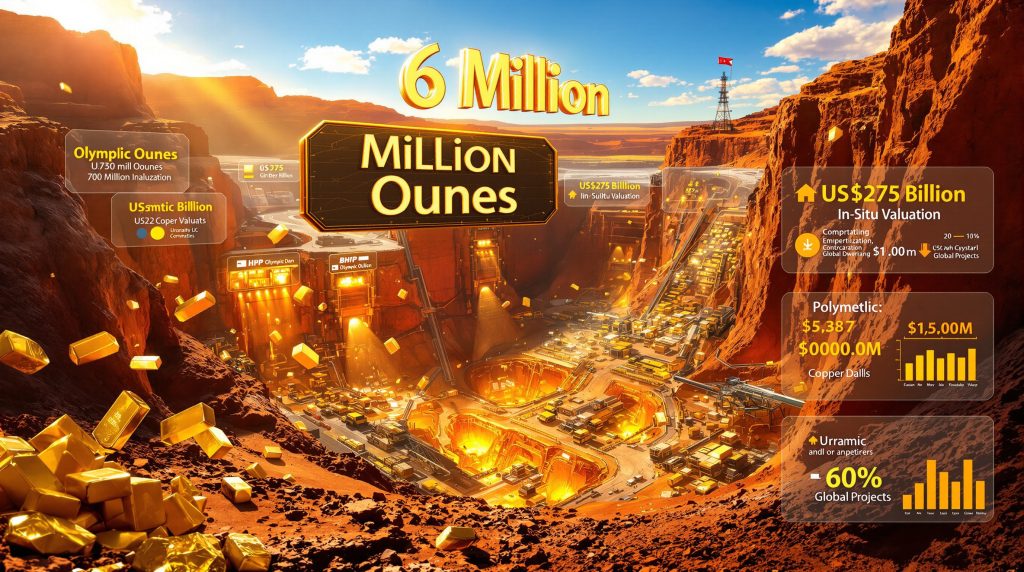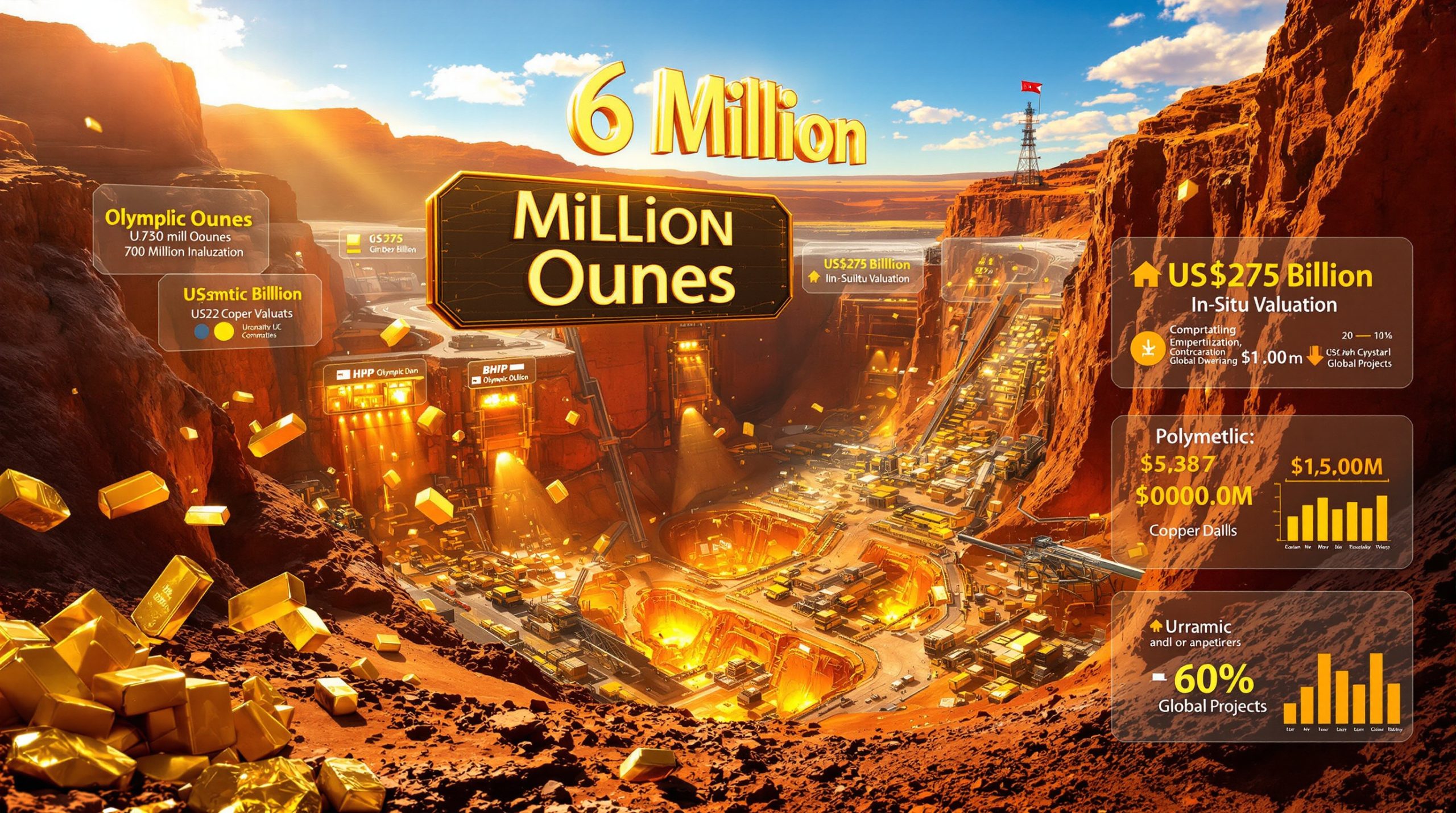BHP Group Limited stands as one of the world's largest diversified mining companies, primarily recognised for iron ore and metallurgical coal production supporting global steelmaking operations. The Australian mining giant also claims the title of world's largest copper producer, supplying critical materials for industrial applications and the energy transition. However, BHP's gold project ranking has recently thrust the company into an unexpected spotlight within the precious metals sector, particularly as analysts examine gold market performance in today's volatile economic climate.
The company's portfolio extends beyond traditional commodities to include nickel assets in Western Australia and the advancing Jansen potash project in Canada. This diversification strategy positions BHP uniquely in the mining landscape, where most operators focus on single commodity streams.
Understanding BHP's Polymetallic Mining Strategy
BHP's approach to gold extraction differs fundamentally from traditional gold mining companies. Rather than developing dedicated gold operations, the company leverages polymetallic deposits where multiple valuable minerals can be extracted economically from single mining complexes. This strategy provides several competitive advantages:
- Revenue diversification across multiple commodity markets
- Operational efficiency through shared infrastructure and processing facilities
- Risk mitigation against single-commodity price volatility
- Capital optimisation through spreading development costs across multiple revenue streams
The polymetallic approach requires sophisticated engineering capabilities and integrated processing systems capable of handling complex ore compositions. BHP's technical expertise in managing these multifaceted operations represents a significant barrier to entry for competitors.
The Economic Value of Integrated Metal Production
Integrated metal production creates substantial economic value through operational synergies that single-commodity mines cannot achieve. When copper serves as the primary revenue driver while gold, uranium, and silver provide supplementary income streams, the combined economics often exceed the sum of individual commodity values.
This integrated approach also provides natural hedging against market cycles. During periods when copper prices decline, higher gold or uranium prices can maintain project economics. Conversely, when precious metals face downward pressure, base metal revenues can sustain operations.
The capital efficiency gains from shared infrastructure mean that development costs per unit of production are significantly lower than constructing separate single-commodity operations. Transportation, power, water, and processing infrastructure serve multiple product streams simultaneously.
How Does Olympic Dam Rank Among Global Gold Projects?
Recent analysis has positioned BHP's Olympic Dam operation as the second largest gold project globally, containing an extraordinary 65.6 million ounces of contained gold. This ranking places Olympic Dam ahead of virtually all dedicated gold mining operations worldwide, despite gold being a secondary product rather than the primary focus.
Breaking Down the 65.6 Million Ounce Gold Reserve
Olympic Dam's massive gold endowment represents one of the largest concentrations of contained gold in any single mining complex. To understand the significance of this resource, consider the global context:
| Global Rank | Project Name | Contained Gold (Million Oz) | Primary Operator | Location |
|---|---|---|---|---|
| 1 | Pebble Project | ~70.0 | Northern Dynasty Minerals | Alaska, USA |
| 2 | Olympic Dam | 65.6 | BHP Group | South Australia |
| 3-7 | Various Projects | 25-50 | Multiple Operators | Global |
| 8 | Filo del Sol | 22.3 | BHP/Lundin Mining | Chile-Argentina Border |
The concentration of 65.6 million ounces within Olympic Dam's polymetallic system demonstrates the deposit's exceptional geological endowment. This gold content exists alongside the world's largest uranium deposit and fourth largest copper deposit, creating unprecedented mineral wealth concentration.
Geographic distribution analysis reveals that most top-ranking gold projects are located in geologically stable regions with established mining infrastructure. Olympic Dam benefits from South Australia's favourable regulatory environment, established transportation networks, and skilled workforce availability.
The US$275 Billion In-Situ Valuation Explained
The US$275 billion in-situ valuation represents the theoretical value of Olympic Dam's contained gold at current market prices. However, this figure requires careful interpretation as it represents metal content in the ground rather than recoverable economic value.
Economic modelling methodologies for in-situ valuations typically include:
- Current spot gold prices multiplied by contained ounces
- No adjustments for extraction costs, processing expenses, or capital requirements
- Theoretical assumption that all contained metal is accessible and recoverable
- Market price assumptions based on recent trading ranges
Market price assumptions and variables significantly impact these valuations. Gold price fluctuations of $100 per ounce translate to approximately $6.56 billion variations in theoretical in-situ value for Olympic Dam's gold content alone.
Long-term value projections must account for several critical factors:
- Recovery rates: Not all contained gold is economically extractable
- Processing costs: Complex polymetallic ores require sophisticated processing
- Capital requirements: Infrastructure development and maintenance costs
- Market timing: Actual extraction occurs over decades, not at current prices
Industry experts emphasise that in-situ valuations provide useful comparative metrics but should not be interpreted as immediate economic value or potential revenue streams.
What Sets Olympic Dam Apart from Traditional Gold Mines?
Olympic Dam's distinction from traditional gold mining operations extends far beyond its ranking as the second largest gold project globally. The operation represents one of the most complex and technologically advanced mining systems in existence.
The Polymetallic Advantage in Modern Mining
Unlike dedicated gold mines that optimise operations around precious metal extraction, Olympic Dam operates as an integrated polymetallic complex where copper serves as the primary revenue driver. This fundamental difference creates unique operational dynamics:
Copper as Primary Revenue Driver:
- Generates the largest portion of annual revenue
- Drives production scheduling and processing optimisation
- Determines overall project economics and expansion decisions
- Provides stable cash flows through industrial demand cycles
Uranium Production Significance:
- Olympic Dam contains the world's largest uranium deposit
- Furthermore, uranium market dynamics can dramatically impact project profitability
- Nuclear fuel demand provides long-term revenue visibility
- Regulatory requirements add operational complexity but create supply constraints
Silver and Rare Earth Elements Contribution:
- Silver production adds substantial supplementary revenue
- Rare earth elements provide exposure to technology sector demand
- Combined minor metals often contribute 15-25% of total revenue
- Processing complexity increases but generates additional value streams
Underground Infrastructure and Operational Scale
The scale of Olympic Dam's underground infrastructure demonstrates the extraordinary complexity of modern polymetallic mining. The operation features approximately 700 kilometres of underground roads and tunnels, representing one of the largest underground mining complexes globally.
Infrastructure Specifications:
- Total tunnel network: ~700 kilometres of underground roadways
- Ventilation systems: Massive air circulation for deep mining operations
- Haulage capacity: Integrated transport systems for multiple ore types
- Processing facilities: Complex metallurgical plants handling diverse ore compositions
- Power requirements: Substantial electrical infrastructure for deep extraction
Production Capacity Metrics:
The integrated nature of Olympic Dam allows simultaneous extraction of multiple commodities through shared infrastructure. This approach achieves economies of scale impossible in single-commodity operations.
Technological Innovations in Deep Mining:
Olympic Dam employs advanced underground mining technologies including:
- Automated haulage systems for improved safety and efficiency
- Real-time ore grade monitoring and optimisation
- Integrated ventilation management for multiple working faces
- Advanced geological modelling for resource optimisation
- Remote monitoring systems for hazardous uranium-bearing areas
Which Other BHP Gold Assets Feature in Global Rankings?
BHP's gold portfolio extends beyond Olympic Dam to include additional world-class projects that demonstrate the company's significant presence in global gold resources, despite gold not being a strategic focus area.
Filo del Sol: The 8th Largest Gold Project Worldwide
The Filo del Sol project, ranking as the 8th largest gold project globally with 22.3 million ounces of contained gold, represents BHP's second major gold asset. Located along the Chile-Argentina border, this development-stage project operates through a joint venture structure with Lundin Mining Corporation.
Joint Venture Structure
Partnership Details: BHP maintains a joint venture with Lundin Mining Corp (TSX: LUN), combining BHP's financial resources with Lundin's regional operational expertise in Latin American mining operations.
Chile-Argentina Border Location Advantages: The international border location provides access to infrastructure from both countries while benefiting from established mining regulations in both jurisdictions.
Development Timeline and Milestones: As a development-stage project, Filo del Sol requires significant capital investment before production begins, with timeline dependent on permitting, financing, and market conditions.
Like Olympic Dam, Filo del Sol represents a polymetallic deposit where copper serves as the primary commodity and gold provides substantial co-product value. This consistency in BHP's gold project ranking demonstrates the company's expertise in managing complex, multi-metal mining operations.
The project's location along the Chile-Argentina border provides several strategic advantages:
- Access to established mining infrastructure in both countries
- Proximity to major copper mining regions with skilled workforce availability
- Multiple transportation route options for product logistics
- Regulatory frameworks familiar with large-scale mining operations
Investment Implications of BHP's Gold Portfolio
BHP's combined gold resources from Olympic Dam (65.6 million ounces) and Filo del Sol (22.3 million ounces) total 87.9 million ounces of contained gold, representing substantial exposure to precious metals markets despite the company's focus on base metals and bulk commodities.
Capital Allocation Strategies:
BHP's approach to gold assets reflects broader capital allocation priorities where gold provides portfolio diversification rather than core growth investment. The company recently announced $840 million in growth projects at Olympic Dam, primarily focused on boosting copper output rather than maximising gold production.
Growth Project Funding Priorities:
- Copper expansion receives primary investment focus
- Gold production optimisation occurs as secondary benefit
- Integrated development reduces per-unit capital requirements
- Shared infrastructure maximises return on invested capital
Market Positioning Benefits:
The substantial gold resources provide BHP with unique market positioning advantages:
- Natural hedging against base metal price cycles through precious metal exposure
- Revenue diversification reducing dependence on iron ore and coal markets
- Strategic optionality to increase gold focus if market conditions warrant
- Competitive differentiation from pure-play base metal or bulk commodity producers
How Do Australian Mining Giants Compare in Gold Production?
Analysis of ASX 200 mining companies reveals limited representation among the world's top-ranking gold projects, highlighting the concentration of major gold resources among international operators rather than Australian-listed entities.
ASX 200 Mining Companies in Global Gold Rankings
Research indicates that few of the world's biggest gold projects are controlled by top Australian mining companies, despite Australia's position as a major global gold producer. This concentration reflects the international nature of large-scale gold project ownership.
| Company | ASX Code | Project Name | Global Ranking | Contained Gold | Status | Joint Venture Partner |
|---|---|---|---|---|---|---|
| BHP Group | BHP | Olympic Dam | #2 | 65.6M oz | Operating | — |
| BHP Group | BHP | Filo del Sol | #8 | 22.3M oz | Development | Lundin Mining |
| Newmont Corporation CDI | NEM | Nevada Gold Mines | #13 | 20M+ oz | Operating | Freeport-McMoRan |
| Newmont Corporation CDI | NEM | Norte Abierto | #15 | ~20M oz | Development | Freeport-McMoRan |
The table demonstrates that only two ASX-listed companies feature prominently in global top-20 gold project rankings: BHP Group and Newmont Corporation CDI. Combined, these companies control approximately 127+ million ounces of contained gold in major projects.
Production Status Classifications:
- Operating projects: Currently producing and generating revenue
- Development projects: Require capital investment before production begins
- Joint venture structures: Shared ownership, development costs, and operational risks
Newmont's Australian Operations and Global Presence
Newmont Corporation, trading as CHESS Depositary Interests (CDI) on the ASX under ticker NEM, represents the primary dedicated gold company with major project holdings in top global rankings.
Nevada Gold Mines Partnership Structure:
The Nevada Gold Mines collaboration between Newmont Corporation and Freeport-McMoRan Inc (NYSE: FCX) ranks as the 13th largest gold project globally with more than 20 million ounces of contained gold. This joint venture demonstrates how major mining companies combine resources to develop world-class projects.
Norte Abierto Project Development:
Located in Chile, the Norte Abierto project ranks 15th globally with nearly 20 million ounces of contained gold. Like Nevada Gold Mines, this project operates through partnership between Newmont and Freeport-McMoRan, spreading development risks and capital requirements.
Comparative Analysis with BHP's Approach:
- BHP Strategy: Gold as co-product in polymetallic systems focused on copper production
- Newmont Strategy: Dedicated gold production with strategic joint ventures
- Risk Distribution: Both companies use partnerships to manage large project risks
- Geographic Diversification: Projects span multiple continents and jurisdictions
Newmont's approach differs fundamentally from BHP's polymetallic strategy. While BHP extracts gold as a valuable co-product from copper-focused operations, Newmont optimises specifically for gold production and recovery.
What Drives the Economics of Large-Scale Gold Projects?
The economics of world-class gold projects like Olympic Dam and Filo del Sol depend on multiple factors beyond simple gold price assumptions. Understanding these drivers provides insight into why polymetallic operations often outperform dedicated gold mines.
Revenue Diversification Through Polymetallic Operations
Risk Mitigation Strategies:
Polymetallic projects provide natural hedging against single-commodity price volatility. When gold prices decline, copper, uranium, or silver revenues can maintain project economics. This diversification reduces the overall risk profile compared to single-commodity operations.
Market Volatility Protection:
Historical analysis demonstrates that polymetallic operations experience lower revenue volatility than single-commodity mines. The correlation coefficients between different metal prices are typically less than perfect, creating natural portfolio effects within individual mining operations.
Operational Efficiency Gains:
- Shared infrastructure costs across multiple product streams
- Integrated processing facilities handling multiple ore types simultaneously
- Combined haulage and transportation systems reducing per-unit logistics costs
- Optimised workforce utilisation across different mining and processing activities
Capital Investment Requirements for Mega-Projects
Large-scale gold projects require substantial capital investments that extend far beyond initial development costs. Olympic Dam's recent growth announcement illustrates these requirements.
BHP's $840 Million Olympic Dam Investment
Growth Project Objectives: The investment primarily targets increased copper production capacity, with gold production benefits occurring as a co-product outcome rather than primary focus.
Expected Production Increases: While specific gold production targets were not disclosed, the integrated nature of Olympic Dam means copper expansion directly impacts gold output volumes.
Timeline for Implementation: Large-scale underground mining expansions typically require 3-5 years for full implementation, with production increases occurring gradually as new infrastructure comes online.
Capital Categories for Mega-Projects:
- Initial Development Capital: Mine development, processing facilities, infrastructure construction
- Sustaining Capital: Ongoing equipment replacement, facility maintenance, expansion projects
- Growth Capital: Capacity expansions, new mining areas, technology upgrades
- Environmental and Social Capital: Remediation, community programs, regulatory compliance
Why Are Copper-Gold Projects Becoming More Valuable?
The strategic value of copper-gold projects has increased significantly due to global trends in energy transition, supply chain security concerns, and evolving portfolio management strategies among institutional investors.
Energy Transition Metal Demand Trends
Copper's Role in Renewable Energy Infrastructure:
The global energy transition requires massive copper consumption for electrical infrastructure, renewable energy systems, and energy storage technologies. Electric vehicles, solar panels, wind turbines, and grid modernisation all require substantial copper inputs, creating long-term demand growth.
Electric vehicle production alone requires approximately 4 times more copper than traditional internal combustion vehicles. As electric vehicle adoption accelerates globally, copper market insights suggest demand from this sector is projected to increase exponentially through 2030 and beyond.
Gold's Position as Portfolio Diversification Asset:
Institutional investors increasingly view gold as essential portfolio diversification against inflation, currency debasement, and geopolitical risks. Central bank gold purchases have reached multi-decade highs, supporting long-term price stability and demand growth.
Gold's role as a monetary hedge becomes more important during periods of:
- High inflation or currency instability
- Geopolitical tensions and trade conflicts
- Financial market volatility and uncertainty
- Central bank monetary policy transitions
Supply Chain Security Considerations:
Recent supply chain disruptions have highlighted the strategic importance of secure, domestic or allied-nation mineral supplies. Copper-gold projects in stable jurisdictions like Australia provide supply security that pure commodity pricing cannot capture.
Geographic Risk Distribution in Mining Portfolios
Political Stability Factors:
Mining companies increasingly prioritise operations in jurisdictions with stable political systems, established rule of law, and predictable regulatory frameworks. Australia's AAA credit rating and stable mining regulations provide competitive advantages for projects like Olympic Dam.
Regulatory Environment Comparisons:
- Australian Operations: Established permitting processes, environmental standards, labour regulations
- Latin American Projects: Variable regulatory stability, potential for policy changes, higher political risk premiums
- African Operations: Higher risk premiums but potentially lower operating costs
- North American Projects: Generally stable but increasing environmental scrutiny
Infrastructure Development Requirements:
Established infrastructure reduces project development costs and timeline risks. Olympic Dam benefits from existing transportation networks, power systems, and skilled workforce availability that many international projects lack.
How Will BHP's Gold Projects Perform in Future Markets?
BHP's gold assets are positioned to benefit from several long-term trends while facing unique challenges related to their polymetallic nature and the company's strategic priorities focused on base metals and energy transition materials.
Production Expansion Plans and Timelines
Olympic Dam Growth Initiatives:
BHP's $840 million investment in Olympic Dam growth projects represents the most significant near-term catalyst for increased gold production from the company's portfolio. While copper expansion drives these investments, the integrated nature of Olympic Dam means gold production will increase proportionally.
The growth initiatives focus on:
- Underground mining expansion to access higher-grade ore bodies
- Processing facility optimisation to handle increased throughput volumes
- Infrastructure development supporting higher production rates across all commodities
- Technology integration improving operational efficiency and recovery rates
Filo del Sol Development Phases:
As a development-stage project, Filo del Sol represents significant longer-term gold production potential. The 22.3 million ounce gold endowment positions this project as a major future contributor to BHP's precious metals production.
Development timeline considerations include:
- Permitting processes across Chile-Argentina border jurisdictions
- Infrastructure construction including access roads, power supply, water systems
- Processing facility development capable of handling polymetallic ore compositions
- Market timing decisions based on copper and gold price environments
Market Position Strengthening Through Scale
BHP's substantial gold resources provide unique competitive positioning advantages that pure-play gold producers and single-commodity miners cannot replicate.
Competitive Advantages
Operational Expertise in Complex Mining: BHP's experience managing integrated polymetallic operations creates barriers to entry that protect project economics and provide operational expertise advantages over competitors.
Financial Resources for Long-Term Development: As one of the world's largest mining companies, BHP possesses financial capacity to develop large-scale, capital-intensive projects that smaller operators cannot finance independently.
Integrated Supply Chain Capabilities: BHP's global operations and established customer relationships provide marketing and logistics advantages for multiple commodity streams from individual projects.
Scale Advantages in Market Cycles:
Large-scale operations can maintain economic viability during commodity price downturns when smaller projects become uneconomical. This operational resilience provides competitive advantages during market cycles.
Strategic Optionality:
BHP's gold resources provide strategic optionality to increase precious metals focus if market conditions warrant, without requiring acquisition of new assets or development of new operational capabilities.
What Should Investors Know About BHP's Gold Strategy?
Investors evaluating BHP's gold exposure must understand that precious metals represent a secondary consideration within the company's broader strategic focus on base metals and energy transition materials, despite holding world-class gold resources.
Financial Performance Metrics and Projections
Revenue Contribution Analysis:
Gold contributes a relatively modest portion of BHP's total annual revenue compared to iron ore, metallurgical coal, and copper. However, the high-margin nature of gold production means precious metals contribute disproportionately to profitability.
At Olympic Dam, revenue allocation typically follows this pattern:
- Copper: 60-70% of project revenue
- Uranium: 15-25% of project revenue
- Gold: 10-15% of project revenue
- Silver and other metals: 5-10% of project revenue
Profitability Margins by Metal Type:
Gold typically generates higher profit margins than base metals due to:
- Lower processing costs per unit of value produced
- Premium pricing for high-purity gold products
- Stable demand and established global markets
- Lower transportation and logistics costs
What Does the Gold Price Forecast Mean for BHP's Rankings?
Given current market conditions and the gold price forecast 2025 outlook, BHP's gold project ranking could become increasingly valuable. Recent gold price highs analysis suggests that the theoretical value of Olympic Dam's 65.6 million ounces continues to appreciate.
Capital Return Expectations:
BHP's gold assets contribute to shareholder returns primarily through:
- Dividend support from high-margin gold production cash flows
- Portfolio diversification reducing overall earnings volatility
- Strategic value providing optionality for future precious metals focus
- Asset appreciation as gold reserves increase in value over time
Risk Assessment for Large-Scale Mining Investments
Geological Risk Factors:
Large-scale, long-life mining operations face geological risks that can impact gold recovery and production economics:
- Grade variability affecting processing efficiency and recovery rates
- Metallurgical complexity in polymetallic ores requiring sophisticated processing
- Resource extension risk as mining progresses into less-characterised areas
- Structural geology challenges in deep underground mining operations
Market Price Sensitivity Analysis:
While polymetallic operations provide natural hedging, gold price movements still significantly impact project economics:
- $100/oz gold price change impacts Olympic Dam's theoretical value by approximately $6.6 billion
- Correlation analysis shows imperfect correlation between copper and gold prices provides portfolio benefits
- Long-term price assumptions critical for investment decision-making and project valuations
Regulatory Compliance Considerations:
Large-scale mining operations must navigate complex regulatory environments:
- Environmental compliance costs increasing over time with stricter standards
- Community relations requiring ongoing social investment and stakeholder management
- International trade regulations affecting global commodity markets
- Taxation policy changes impacting project economics and investment returns
Investment decisions should consider multiple risk factors including commodity price volatility, operational complexity, regulatory changes, and broader market conditions. Past performance does not guarantee future results, and mining investments carry inherent risks related to geological, operational, and market factors.
Further Exploration:
Readers interested in learning more about global gold project rankings and mining industry analysis can explore additional educational content from BHP Group's official publications and various mining industry publications that provide comprehensive data on worldwide mineral resources and production statistics.
Looking to Invest in World-Class Gold Resources?
Discovery Alert's proprietary Discovery IQ model delivers real-time alerts on significant ASX mineral discoveries, instantly empowering subscribers to identify actionable opportunities ahead of the broader market. Visit Discovery Alert's dedicated discoveries page to understand why major mineral discoveries can lead to substantial returns, then begin your 30-day free trial today to secure your market-leading advantage.




